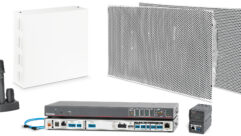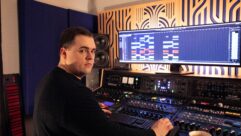Now Hear This
Dec 1, 2002 12:00 PM,
Russell Gentner
Every classroom in North America should have a sound system. That may sound like a crazy idea, but it’s not that far-fetched. Educators across America are discovering that with classroom sound systems, referred to as sound fields, students’ learning abilities and grades are improving. Traditionally, hearing-impaired children wore assistive listening devices (ALD) so they could more effectively hear their teachers. State and federal laws require such devices. However, wearing the devices has proven to be an embarrassment for students and a headache for educators. Thus, the concept of sound field was born.
HOW SOUND FIELD WORKS
The teacher wears a portable transmitter and microphone. The transmitter broadcasts to a receiver/amplifier that picks up the sound and drives one to six speakers in the room. Students love the simple and effective system, and with ever-increasing class sizes, teachers love it, as well. The system minimizes voice strain and helps increase a class’s attention level.
The results of using the system have been surprising. First, sound field is effective for students with mild to moderate hearing loss. Second, it solves the embarrassment and logistical issues of handing ALDs to students who were destined to destroy the devices anyway. But here’s the surprise: students without hearing loss showed improved learning abilities because of sound field. With more than 3 million classrooms in North America, sound field represents a potential market of more than $1.5 billion.
This discovery offers a significant opportunity for system contractors, who must consider three key issues: what are the product and technological issues relating to sound-field systems? What are the support issues after the sale? How do you take advantage of this opportunity?
Designing and installing sound-field systems is relatively simple and straightforward. However, several technological issues must be addressed, or they will become a nuisance once the system is installed. A basic sound field consists of a portable transmitter, either radio frequency (RF) or infrared (IR), and a self-powered speaker as illustrated in Fig. 1.
More complex sound-field systems use a separate receiver — power amplifier and individual speakers to produce an integrated component system (see Fig. 2). In this example, speakers are generally mounted in the ceiling or inside walls.
TECHNOLOGICAL ISSUES
Two types of transmission systems are being used: RF and IR. Wireless microphones (VHF and UHF) and assistive listening systems (72 MHz and 216 MHz) are used for RF sound-field systems. These systems are cost-effective, are easy to install, and work dependably. The main problem with RF systems occurs when multiple sound-field systems are used in one school. Because that is typical, the interference caused by multiple transmitters has been the key technological problem in the installation of such systems.
To solve this problem, IR systems have gained some acceptance for sound field. IR systems can provide an infinite number of systems in a school, because their signals cannot penetrate classroom walls. Whereas the problem of interference was solved with IR, a new set of problems was created. First, interference from sunlight, fluorescent bulbs, and other light sources make some IR systems difficult or impossible to use. Second, the shadowing between the IR transmitter and IR receptor creates dropouts of the sound. Generally, the problems associated with IR are so unworkable that RF systems (even with their inherent interference issues) are more practical for sound-field installations (see the table, “RF and IR”).
WIRELESS MICS AND ALS PRODUCTS
Wireless microphones offer a good choice for sound-field systems when a limited number of channels is used in a component application (in which you are going to build the system out of individual components). Wireless microphones are designed for excellent sound quality and relatively long range. However, good wireless microphones are somewhat expensive. Because the typical classroom is usually not a large area, ALS systems in the 72 MHz band are probably a better choice because of less transmission range and lower cost. More importantly, ALS manufacturers are building systems specifically for use in sound-field applications. That will minimize time and money that is required in designing, specifying, installing, and supporting a system.
When designing and installing an RF system, you need to choose frequencies that minimize interference among systems. In addition, select a product that offers an adjustable squelch control. By setting the squelch adjustment at a high setting, the receiver captures the transmitting channel when the teacher has it on. When it’s off, it ignores interference caused by adjacent and intermodulation signals. The one technological advantage the sound-field setting has is that the teacher is generally only a few feet from the receiving antenna. This signal is so strong that interference from outside sources is not an issue (at least when the teacher’s transmitter is on). The problem crops up when the teacher turns the transmitter off. When that happens, the receiver is susceptible to hearing the interference from adjacent and intermodulation RF sources. By setting the squelch threshold high, the receiver can be set to ignore the interfering RF sources.
One of the bigger long-term issues of the portable transmitter that is worn by the teacher is battery management. It is important that you choose a transmitter that can operate at least eight hours without a battery charge. In this application, rechargeable batteries are a must. Make sure you order an individual charger for each teacher’s transmitter or a drop-in charger for multiple units that can be centrally located for all of the teachers in the school.
SUPPORT ISSUES
For systems not designed and installed properly, interference can be your biggest support issue. Take the time to design and calibrate a system with minimized interference issues. Make sure you work with the school to create a transmitter designation system so that it is clear which transmitter is used in which room. One way of solving the problem is to suggest that the transmitter not leave the classroom. You can also use a system with a built-in LCD, which makes it easy for the teacher to see what channel he or she is broadcasting on.
In addition, you need a foolproof transmitter. The most important feature is ease of use. Transmitters should be capable of being locked on channel, eliminating accidental channel changes during the school day.
The logistics of battery charging are important, too. The school needs to understand that rechargeable batteries do not last forever. It’s a good practice to replace them at the start of each school year. You don’t need to be told more than once that a system must be installed so that the students can’t get their grimy little hands on it. Mount the equipment out of sight or you’ll be back putting in a new one.
Most schools like the idea of an ongoing maintenance contract. That keeps the systems operating without a surprise expense during the school year. When selling a system, consider this possibility not only as an ongoing revenue source for your company but also as an increase to your customer’s long-term satisfaction. The maintenance contract should cover ongoing, on-site repair and recalibration of the system. It is typical in school systems to conduct an annual refurbishment of the system during the summer vacation period. During that time, verify proper operation of each component of each system and perform any necessary repairs. It’s also a good time to time to replace the rechargeable batteries.
SELLING
Sound-field systems are sold directly to the school or, more likely, through the school district. The purchase cycle starts in September and runs through June, so it’s important to be in front of the decision makers well before the purchase cycle begins. Depending on the cost of the proposal, schools will often put the system out to bid more than a year in advance. However, your local presence, support, and service may be more important to the school than the final price. Likewise, sudden needs can arise (such as angry, vocal parents demanding the installation of an auditory assistance system for their child). Once one school within a district starts to implement the sound-field system, the sales begin to snowball as schools and districts talk to each other.
The person to contact at the school district or school may have one of the following titles: media coordinator, A/V technician, technology specialist, MIS coordinator, computer science coordinator, English-as-a-second-language coordinator, multimedia services, information coordinator, or technology librarian. The principal can also point you in the right direction.
It’s a good idea to put together multiple demonstration systems. Be prepared to leave the system with the decision maker so he or she can demonstrate the system to potential users. Have your maintenance program worked out in advance and provide it in writing with your demo system. That should be part of your sales presentation.
It’s helpful to remember some key selling points of sound-field systems. The systems might be required by law in some states, and they help all students learn (hearing impaired or not), ease voice strain, and increase class attention. In addition, remind your client that you will provide local installation, training, and ongoing support.
Schools are just now starting to implement sound field. With a market potential of $1.5 billion, this is an opportunity that deserves some attention.
Russell Gentner is the president of Listen Technologies.










